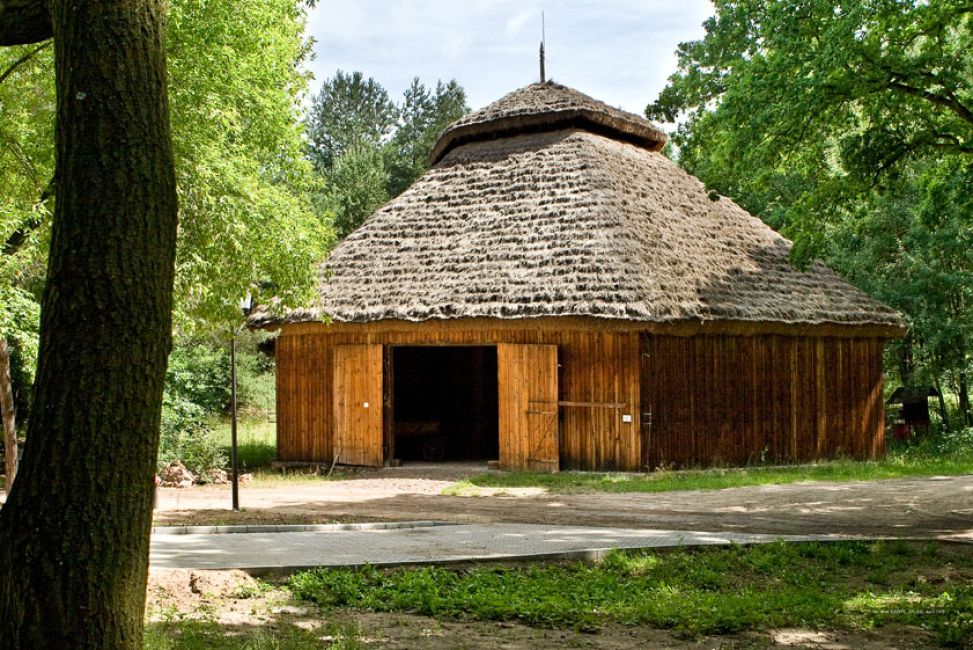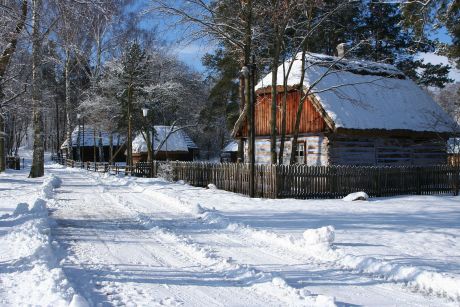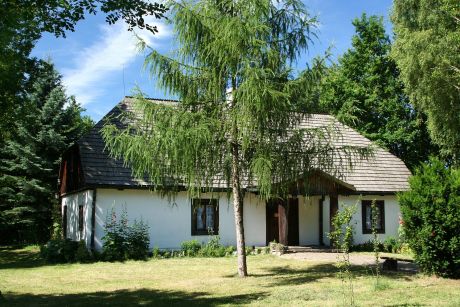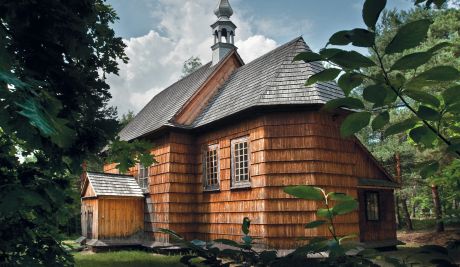Because of its unusual shape (as for the region of Radom) and an interesting exhibition of rural means of transport, the barn from Grójec evokes a live interest of all the visitors. Common delight is aroused by its monumental structure, visible from the inside. The building’s block is architectonically strange for the local landscape, because its first owners were Russians. The barn was erected in the middle of the 19th century for the needs of an entailment, i.e. a land property, the owner of which was a tsar officer. Modelled upon Great Russia barns, the object has been a silent witness of a tragic history of Poland, which in the 19th century was annexed and occupied by foreign military forces.
The barn is built upon a hexagonal view. Its walls in a framework structure are boarded vertically from the outside. An interesting element of the building’s block is constituted a six-hipped roof covered with straw thatch, above which one may find a tower also covered with a six-hipped straw roof. The tower is equipped with skylights – glazed windows which provide daylight into the interior. Hence, the tower is called a lantern. Initially the building was equipped with two pair of clean through gates, placed asymmetrically. Inside there were six places for crops, three out of which were occupied by the crops. The rest of them contained: a basement, bricked processing place and a place for straw cutting with a wooden floor.
The monuments belong to a very interesting group of polygonal barns, i.e. the ones built upon a polygonal view. These forms were more common upon the area of Silesia and in the region of Cracow, in farms owned by rich peasants. They started to disappear in the second half of the 19th century because of the introduction of new, more cost-effective techniques of construction of walls. Apart from Poland, such barns were present upon the territory of Russia, Volhynia, Polesia and Ukraine, Hungary, Slovakia, Moravia and Czech Republic. Their existence was also confirmed in Thuringia in Germany. In Radom Village Museum the building was adjusted to the needs of exhibition of the transport means, entitled “Upon a village road…”. The back gate was removed and the original division of the barn disappeared. Former places for crops were equipped with platforms, which present sledges and wheel coaches.
Sledges, which nowadays are associated with sleighing parties organized in the winter and a joyful fun, were indispensible means of transport of people and goods in winter and upon wet and muddy areas. Small and apparently childish sledges were necessary in order to transport loads inside the farm or in the nearest area. Probably at first, parts of the sledges were made of animal bones. It is confirmed by their names, such as “bones” (gnaty) or the fact that the bottom jaw of the animal was referred to as “the sledge”.
The exhibition shows representative peasant sledges, used only for special occasions and double working sledges, known as “psiak” (dog) as well as decorative manor sledges and small coach sledges.
Along with the development of roads, wheel vehicles started to be used for transport. The structural development of the chassis consisted in the replacement of a mobile axis (wheels rotate with the axis) with an immobile axis (wheels rotate without axis), the replace ment of a full wheel with a spoke wheel. The exhibition is dominated by an economic vehicle in a development structure, built of a chassis, ladders, board of the bottom of the vehicle as well as four appropriately forged rods which stabilize the chassis with the body with ladders, packages or a coach. With time only vehicles for transport of people started to be manufactured. The chasses were equipped with suspension springs in order to level the vibrations of the vehicle caused by the bad quality of roads, whereas the body was equipped with more comfortable, couch-like seats and a roof was added. All such solution made travelling more convenient and less tiring. In such a manner horse carriages, coaches and droshkies were made.
The exhibition “Upon a village road…” pre - sent long suspended vehicles used for trans - porting of more passengers. The blue one used to go from the train station in Szydłowiec to the city market; the second one trans - ported Jewish buyers from the region of Iłża to fair in Ostrowiec. The exhibition is enriched with: a coach, control wheels, coaches as well as noble and peasant horse carriages. Horse carriage were used by peasants as they got richer and started to follow the manner of travelling presented by the nobility and rich citizens.
The exhibition of machines and agricultural devices organized in a special pavilion in the Museum is not a lecture on the history of “from a shovel to a harvester” but rather an illustration of the mechanization of regional farms which gradually started to use different devices of different origins: from autarky and craftsmanship to the industry, from the pro - duction for one’s own purposes to the obtain - ment of ready devices, through replacement (including post-war appropriation from post- German farms) to the formal purchase in the unit of agricultural supply. A novelty in the Museum are tractors known as SAM. These are building structures which were built by the farmers themselves after the Second World War. Independent construction of tractors and other agricultural machines was a manner to mechanize the farms after war damages and poverty of individual agriculture. This phenomenon was present in Poland, Germany, Austria, France or Italy. Countries with the market economy have quickly managed the problems of agricultural supply. However, the opposite happened in the post-war Poland, where individual agriculture under the influence of the Communist ideology was under-invested. The manufacture of SAM tractors was hence sometimes the only effective method of mechanization of the agriculture. The production developed in Poland in an unusual scale.











